Large-tusked elephants are in decline
Posted: Fri May 24, 2019 11:31 am
Large-tusked elephants are in decline, need to be protected from trophy hunting and poaching, says researcher
Posted on 23 May, 2019 by Guest Blogger in Conservation, Hunting, Poaching, Research, Wildlife and the Decoding Science post series.
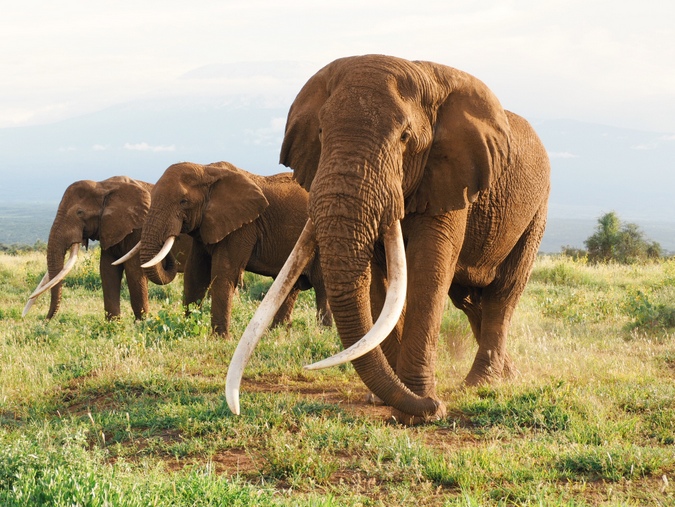
Tim, the magnificent big tusker, in Amboseli National Park, Kenya © Selengei Poole-Granli
Written by Dr. Michelle Henley – Elephants Alive Director, Co-founder and Principal Researcher
Elephants are often valued by the size of their tusks, either for direct consumptive use (poaching and trophy hunting) or non-consumptive use (photographic tourism). They also have enormous non-use values which include their role as vital ecosystem engineers and their cultural or spiritual value to people other than simply their existence value. It is, though, the emphasis on tusk size that is the focus of this report, and there is a concern that large-tusked elephants are being unsustainably removed through consumptive use.
Tusk size is sexually dimorphic, with the tusks of bulls increasing on average, at 11 cm per year while female tusks increase at 8.5 cm per year (Spinage 1994). Large tusks are associated with older bulls, not only because elephant’s tusks grow throughout their lives (Pilgram & Western 1986) but also because their tusks grow faster towards the latter half of a bull’s life (Laws 1966, Spinage 1994). Younger elephant bulls’ tusks increase in weight at 2g per day i.e. 730g per year. In older bulls, as the tusk pulp cavity fills, the increase in weight accelerates towards the end of the bull’s life (Spinage 1994).
Overall, sexual selection has perpetuated indiscriminate growth, delayed competitive breeding and contributed to selection for longevity in elephant bulls (Rasmussen et al. 2008), all factors that are coupled with a propensity for large tusks.
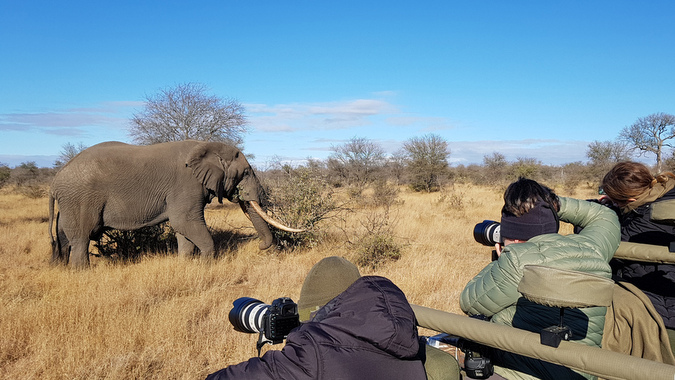
The gentle giant, Apollo © Simon Espley
Poaching and trophy hunting of elephants is often biased towards the largest, oldest bulls within a population, making these individuals scarce in most populations (Marais et al. 2006, Douglas-Hamilton 1997, Spinage 1994, Selier 2014). The illegal killing of elephants has become unsustainable since 2010, peaking in 2011 with an estimated annual off-take of 8% (Wittemyer et al. 2014).
These mortality rates exceed the maximum annual reproductive rate of 7% and with continuation of these trends we are experiencing a continental decline in elephant numbers of approximately 3% (Calef 1988, Said et al. 1995, Wasser et al. 2008; Wasser et al. 2009, Wittemyer et al. 2014). The average tusk size has progressively decreased over the past three decades (Millner-Gullard & Beddington 1993).
In 1979, one tonne of ivory represented approximately 54 dead elephants (bulls with an average tusk weight of 9.3 kg each side). By 1987 the average tusk weight was 4.7 kg with one tonne of ivory representing 113 dead elephants (including cows with a consequential 55 calves that would be orphaned and die). Thus in the space of eight years more than double the amount of elephants needed to be killed to deliver the same amount of ivory (Spinage 1994).
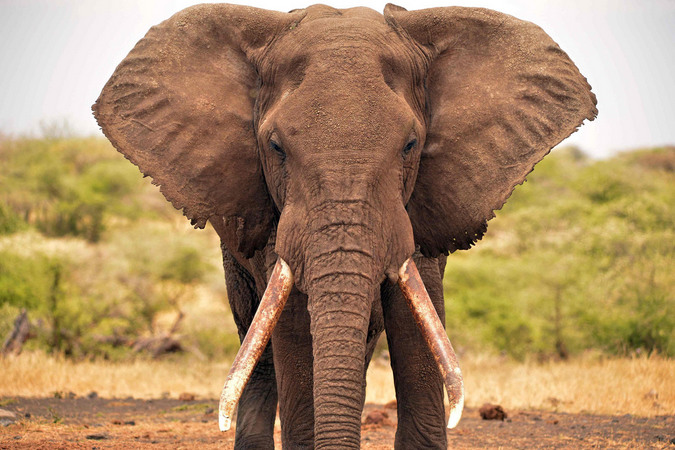
A large-tusked elephant called Spirit in Greater Amboseli Ecosystem, Kenya © Abby Tochterman
More than 10 years down the line, similar trends are being reported with initial upsurges in poaching incidents indicating a biased towards males because of their larger tusk size. Over time, ivory seizure records indicate an increase in the number of female matriarchs poached as bulls with larger tusks become scarce (Mondol et al 2014). Likewise, trophy hunting is highly selective of animals of specific age and sex groups with outstanding physical features (Joubert 1996). Genetically, there is concern that long-term selective off takes of larger tusked bulls will ultimately depress the quality of trophies (Stalmans et al. 2003), erode fine-scaled genetic structure (Archie et al. 2008) and lead to increased reproductive skew, which may increase the rate at which genetic diversity is lost from natural elephant populations (Archie et al. 2012).
There is some evidence of trends towards smaller tusks in southern Africa due to trophy hunting with concern for a temporal shift in heritable traits such as tusk size (Nuzzo & Traill 2014). Over exploitation of older bulls may also socially disrupt elephant populations. Older bulls are preferred as mates by females, are known to have higher paternity success, suppress musth in younger bulls, promote group cohesion and function as ‘mentors’ within bachelor groups (Poole 1997; Hollister-Smith 2005, Rasmussen 2005; Slotow et al. 2001; Evans & Harris 2008, Chiyo et al. 2011, Archie & Chiyo 2012).
With escalating reports on the illegal trade in ivory and more pressure to increase the limits on trophy sizes due to their monetary value, we need to safeguard large-tusked and potentially large-tusked individuals in populations where they still occur.
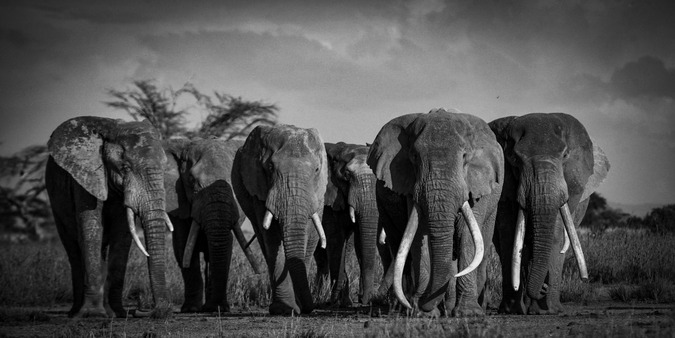
Tim leads an entourage of companions through the Kimana Sanctuary, southern Kenya © Ryan Wilkie
Unlike many reserves in Africa, the Kruger National Park (KNP) in South Africa is vulnerable to illegal killings but as yet has not been subjected to heavy poaching of elephants for ivory. Several large tusked bulls are still found within the well-protected borders of the KNP (SANParks 2014) and other reserves such as Tembe National Park. Although hunting is not allowed within any of the National Parks administered by South African National Parks (SANParks), controlled hunting is permitted on land sharing unfenced boundaries with national parks and outside of these protected areas based on the premise that the population is large enough to allow the removal of a limited number without altering or affecting the population size and structure (age and/or sex ratios, or social structures).
The Greater Mapungubwe Transfrontier Conservation Area (GMTFCA), and The Greater Limpopo Transfrontier Park Conservation Area (GLTPCA) with the latter including the Kruger National Park (KNP) and the adjoining Private Reserves to the west of the KNP, represent Transfrontier Parks where cross border movements of elephants can take place (Henley 2012, Cook 2014, Selier et al. 2014), and where trophy hunting does occur in places.
As trophy hunting is permitted in most regions adjoining National Parks such as the KNP and as few of these conservation areas have implemented strict protocols on upper tusks weight limits, the remaining large tusked bulls could be subjected to over-exploitation and a consequential lowering of the photo-tourism value of these areas. Hence the need to protect large-tusked and potentially large-tusked individuals from poaching and excessive selective hunting pressure.
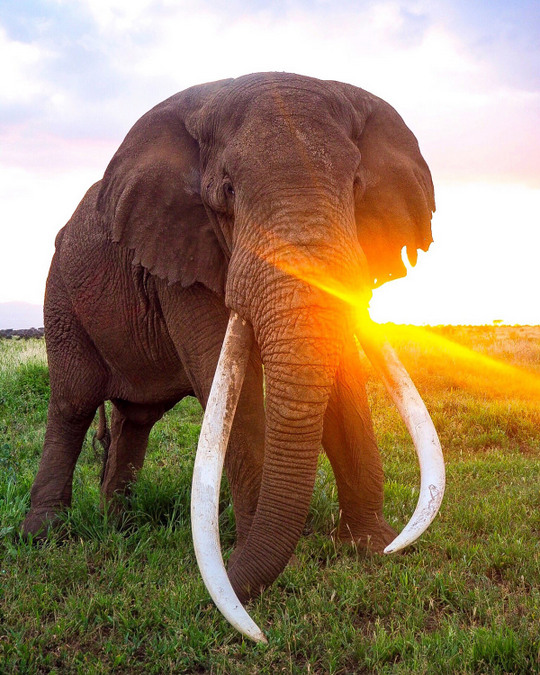
Tim at sunset © Selengei Poole-Granli
DEFINITIONS
A potentially-large tusked elephant can be defined as any elephant younger than 35 years of age, where at least one tusk weighs 60 lbs (~27 kg) and consequently the elephant’s tusk/tusks have the potential, given normal wear and tear, to weigh a minimum of 80-100 lbs when 50-60 years old. These calculations are based on a conservative estimate of a 2g weight increase in tusks per day (~730g per year) without incorporating the exponential increase in tusk weight as the tusk pulp cavity fills with age (Spinage 1994).
A large-tusked elephant can be defined as an elephant which has at least one tusk which weighs a minimum of 100 lbs (45 kg) and can be more than 1.5m in length.

Table 1: Calculations to demonstrate the progression of a potentially-large tusked bull into a large-tusked bull with age.
References
• Archie, E. A., & P. I. Chiyo. 2012. Elephant behaviour and conservation: social relationships, the effects of poaching, and genetic tools for management. Molecular Ecology 21:765–778.
• Archie, E. A., J. E. Maldonado, J. A. Hollister-Smith, J. H. Poole, C. J. Moss, R. C. Fleischer, & S. C. Alberts. 2008. Fine-scale population genetic structure in a fission–fusion society. Molecular Ecology 17:2666–2679.
• Blignaut, J., M. De Wit and J. Barnes. 2008. The economic value of elephants. in: R. J. Scholes and K. G. Mennell, editors. Elephant management. A scientific assessment for South Africa. Wits University Press, Johannesburg
• Calef, G.W. 1988. Maximum rate of increase in the African elephant. African Journal of Ecology 26: 323-327.
• Chiyo, P.I., Archie, E.A., Hollister-Smith, J., Lee, P.C., Poole, J.H., Moss, C.J. & Alberts, S.C. 2011. Association patterns of African elephants in all-male groups: the role of age and genetic relatedness. Animal Behaviour 81: 1093-1099,
• Cook, R.M. 2014. Changes in African elephant (Loxodonta africana) movement patterns at various distances from villages. BSc (Hons) thesis, University of the Witwatersrand, Johannesburg.
• Douglas-Hamilton, I. 1997. Proposal for “green hunting” of elephants as an alternative to lethal sport hunting. Pachyderm 24: 30-32.
• Evans, K. E. & Harris, S. 2008. Adolescence in male African elephants, Loxodonta africana, and the importance of sociality. Animal Behaviour 76: 779-787.
• Henley, M.D. 2012. US Fish and Wildlife Services Assistance Award – Final Performance Report. Unpublished report to the US Fish and Wildlife Services. 42pp.
• Hollister-Smith, J.A. 2005. Reproductive behaviour in male African elephants (Loxodonta africana) and the role of musth: a genetic and experimental analysis. PhD thesis, Duke University.
• Joubert. 1996. Master plan for the Management of the Associated Private Nature Reserves. 206pp.
• Laws, R.M. 1966. Age criteria for the African elephant, Loxodonta africana. East African Wildlife Journal 4: 1-37.
• Marais J & Hadaway S. 2006. Editors. Great Tuskers of Africa. Johannesburg, South Africa: Penguin Books.
• Milner-Gulland, E.J., Beddington, J.R. 1993. The exploitation of elephants for the ivory trade: an historical perspective. Proceedings of the Royal Society of London B 252:29–37.
• Mondol, S., Mailand, C.R. & Wasser, S.K. 2014. Male biased sex ratio of poached elephants is negatively related to poaching intensity over time. Conservation Genetics 15: 1259-1263.
• Nuzzo, M.C. & Traill, L.W. 2014. What 50 years of trophy records illustrate for hunted African elephant and bovid populations. Notes and Records. African Journal of Ecology 52: 250-253.
• Pilgram, T. & Western, D. 1986. Managing African elephants for ivory production through ivory trade regulations. The Journal of Applied Ecology 23: 515-529.
• Poole, J. H. 1997. Elephants. Voyageur Press, USA.
• Rasmussen, H.B. 2005. Reproductive tactics of male African savannah elephants (Loxodonta africana). PhD thesis, University of Oxford, Oxford.
• Rasmussen, H.B., Okello, J.B.A., Wittemyer, G., Siegismund, H.R., Arctander, P., Vollrath, F. & Douglas-Hamilton, I. 2008. Age- and tactic-related paternity success in male African elephants. Behavioural Ecology 19: 9-15.
• Said, M. Y., Chunge, R. N., Craig, G. C., Thouless, C. R., Barnes, R. F. W. & Dublin, H. T. 1995. African Elephant Database 1995. Occasional Paper of the IUCN Species Survival Commission. IUCN, Gland, Switzerland and Cambridge, UK.
• Selier, S.A.J., Page, B.R., Vanak, A.T. & Slotow, R. 2014. Sustainability of elephant hunting across International borders in Southern Africa: A case study of the Greater Mapungubwe Transfrontier Conservation Area. Journal of Wildlife Management 78(1), 122-132.
• Slotow, R., Balfour, D & Howison, O. 2001. Killing of black and white rhinoceros by African elephant in Hluhluwe-Umfolozi Park, South Africa. Pachyderm 31:14-20.
• South African National Parks’ Honorary Rangers. 2014. Kruger Legends Great Tuskers of the Kruger National Park, SANParks, Letaba Elephant Hall, South Africa.
• Spinage, C.A. 1994. Elephants. T & A D Poyser, London.
• Stalmans, M, Attwell, B & Estes, L. 2003. Hunting in the Associated Private Nature Reserves. Environmental Impact Assessment Process. Final Scoping Report to the Department of Finance and economic Development (Limpopo Provincial Government). 100 pp.
• Wasser, S.K., Clark, B. & C. Laurie. 2009. The ivory trail. Scientific American 301: 68-76.
• Wasser, S.K., Clark, W.J., Drori, O., Kisamo, E.S., Mailand, C., Mutayoba, B., & Stephens, M., 2008. Combating the Illegal Trade in African Elephant Ivory with DNA Forensics. Conservation Biology 22, 1065-1071.
• Wittemyer G, Northrup J,M, Blanc J, Douglas-Hamilton I, Omondi P & Burnham K.P. 2014. Illegal killing of ivory drives global decline in African elephants. PNAS 11 (36): 13117-13121.
Posted on 23 May, 2019 by Guest Blogger in Conservation, Hunting, Poaching, Research, Wildlife and the Decoding Science post series.

Tim, the magnificent big tusker, in Amboseli National Park, Kenya © Selengei Poole-Granli
Written by Dr. Michelle Henley – Elephants Alive Director, Co-founder and Principal Researcher
Elephants are often valued by the size of their tusks, either for direct consumptive use (poaching and trophy hunting) or non-consumptive use (photographic tourism). They also have enormous non-use values which include their role as vital ecosystem engineers and their cultural or spiritual value to people other than simply their existence value. It is, though, the emphasis on tusk size that is the focus of this report, and there is a concern that large-tusked elephants are being unsustainably removed through consumptive use.
Tusk size is sexually dimorphic, with the tusks of bulls increasing on average, at 11 cm per year while female tusks increase at 8.5 cm per year (Spinage 1994). Large tusks are associated with older bulls, not only because elephant’s tusks grow throughout their lives (Pilgram & Western 1986) but also because their tusks grow faster towards the latter half of a bull’s life (Laws 1966, Spinage 1994). Younger elephant bulls’ tusks increase in weight at 2g per day i.e. 730g per year. In older bulls, as the tusk pulp cavity fills, the increase in weight accelerates towards the end of the bull’s life (Spinage 1994).
Overall, sexual selection has perpetuated indiscriminate growth, delayed competitive breeding and contributed to selection for longevity in elephant bulls (Rasmussen et al. 2008), all factors that are coupled with a propensity for large tusks.

The gentle giant, Apollo © Simon Espley
Poaching and trophy hunting of elephants is often biased towards the largest, oldest bulls within a population, making these individuals scarce in most populations (Marais et al. 2006, Douglas-Hamilton 1997, Spinage 1994, Selier 2014). The illegal killing of elephants has become unsustainable since 2010, peaking in 2011 with an estimated annual off-take of 8% (Wittemyer et al. 2014).
These mortality rates exceed the maximum annual reproductive rate of 7% and with continuation of these trends we are experiencing a continental decline in elephant numbers of approximately 3% (Calef 1988, Said et al. 1995, Wasser et al. 2008; Wasser et al. 2009, Wittemyer et al. 2014). The average tusk size has progressively decreased over the past three decades (Millner-Gullard & Beddington 1993).
In 1979, one tonne of ivory represented approximately 54 dead elephants (bulls with an average tusk weight of 9.3 kg each side). By 1987 the average tusk weight was 4.7 kg with one tonne of ivory representing 113 dead elephants (including cows with a consequential 55 calves that would be orphaned and die). Thus in the space of eight years more than double the amount of elephants needed to be killed to deliver the same amount of ivory (Spinage 1994).

A large-tusked elephant called Spirit in Greater Amboseli Ecosystem, Kenya © Abby Tochterman
More than 10 years down the line, similar trends are being reported with initial upsurges in poaching incidents indicating a biased towards males because of their larger tusk size. Over time, ivory seizure records indicate an increase in the number of female matriarchs poached as bulls with larger tusks become scarce (Mondol et al 2014). Likewise, trophy hunting is highly selective of animals of specific age and sex groups with outstanding physical features (Joubert 1996). Genetically, there is concern that long-term selective off takes of larger tusked bulls will ultimately depress the quality of trophies (Stalmans et al. 2003), erode fine-scaled genetic structure (Archie et al. 2008) and lead to increased reproductive skew, which may increase the rate at which genetic diversity is lost from natural elephant populations (Archie et al. 2012).
There is some evidence of trends towards smaller tusks in southern Africa due to trophy hunting with concern for a temporal shift in heritable traits such as tusk size (Nuzzo & Traill 2014). Over exploitation of older bulls may also socially disrupt elephant populations. Older bulls are preferred as mates by females, are known to have higher paternity success, suppress musth in younger bulls, promote group cohesion and function as ‘mentors’ within bachelor groups (Poole 1997; Hollister-Smith 2005, Rasmussen 2005; Slotow et al. 2001; Evans & Harris 2008, Chiyo et al. 2011, Archie & Chiyo 2012).
With escalating reports on the illegal trade in ivory and more pressure to increase the limits on trophy sizes due to their monetary value, we need to safeguard large-tusked and potentially large-tusked individuals in populations where they still occur.

Tim leads an entourage of companions through the Kimana Sanctuary, southern Kenya © Ryan Wilkie
Unlike many reserves in Africa, the Kruger National Park (KNP) in South Africa is vulnerable to illegal killings but as yet has not been subjected to heavy poaching of elephants for ivory. Several large tusked bulls are still found within the well-protected borders of the KNP (SANParks 2014) and other reserves such as Tembe National Park. Although hunting is not allowed within any of the National Parks administered by South African National Parks (SANParks), controlled hunting is permitted on land sharing unfenced boundaries with national parks and outside of these protected areas based on the premise that the population is large enough to allow the removal of a limited number without altering or affecting the population size and structure (age and/or sex ratios, or social structures).
The Greater Mapungubwe Transfrontier Conservation Area (GMTFCA), and The Greater Limpopo Transfrontier Park Conservation Area (GLTPCA) with the latter including the Kruger National Park (KNP) and the adjoining Private Reserves to the west of the KNP, represent Transfrontier Parks where cross border movements of elephants can take place (Henley 2012, Cook 2014, Selier et al. 2014), and where trophy hunting does occur in places.
As trophy hunting is permitted in most regions adjoining National Parks such as the KNP and as few of these conservation areas have implemented strict protocols on upper tusks weight limits, the remaining large tusked bulls could be subjected to over-exploitation and a consequential lowering of the photo-tourism value of these areas. Hence the need to protect large-tusked and potentially large-tusked individuals from poaching and excessive selective hunting pressure.

Tim at sunset © Selengei Poole-Granli
DEFINITIONS
A potentially-large tusked elephant can be defined as any elephant younger than 35 years of age, where at least one tusk weighs 60 lbs (~27 kg) and consequently the elephant’s tusk/tusks have the potential, given normal wear and tear, to weigh a minimum of 80-100 lbs when 50-60 years old. These calculations are based on a conservative estimate of a 2g weight increase in tusks per day (~730g per year) without incorporating the exponential increase in tusk weight as the tusk pulp cavity fills with age (Spinage 1994).
A large-tusked elephant can be defined as an elephant which has at least one tusk which weighs a minimum of 100 lbs (45 kg) and can be more than 1.5m in length.

Table 1: Calculations to demonstrate the progression of a potentially-large tusked bull into a large-tusked bull with age.
References
• Archie, E. A., & P. I. Chiyo. 2012. Elephant behaviour and conservation: social relationships, the effects of poaching, and genetic tools for management. Molecular Ecology 21:765–778.
• Archie, E. A., J. E. Maldonado, J. A. Hollister-Smith, J. H. Poole, C. J. Moss, R. C. Fleischer, & S. C. Alberts. 2008. Fine-scale population genetic structure in a fission–fusion society. Molecular Ecology 17:2666–2679.
• Blignaut, J., M. De Wit and J. Barnes. 2008. The economic value of elephants. in: R. J. Scholes and K. G. Mennell, editors. Elephant management. A scientific assessment for South Africa. Wits University Press, Johannesburg
• Calef, G.W. 1988. Maximum rate of increase in the African elephant. African Journal of Ecology 26: 323-327.
• Chiyo, P.I., Archie, E.A., Hollister-Smith, J., Lee, P.C., Poole, J.H., Moss, C.J. & Alberts, S.C. 2011. Association patterns of African elephants in all-male groups: the role of age and genetic relatedness. Animal Behaviour 81: 1093-1099,
• Cook, R.M. 2014. Changes in African elephant (Loxodonta africana) movement patterns at various distances from villages. BSc (Hons) thesis, University of the Witwatersrand, Johannesburg.
• Douglas-Hamilton, I. 1997. Proposal for “green hunting” of elephants as an alternative to lethal sport hunting. Pachyderm 24: 30-32.
• Evans, K. E. & Harris, S. 2008. Adolescence in male African elephants, Loxodonta africana, and the importance of sociality. Animal Behaviour 76: 779-787.
• Henley, M.D. 2012. US Fish and Wildlife Services Assistance Award – Final Performance Report. Unpublished report to the US Fish and Wildlife Services. 42pp.
• Hollister-Smith, J.A. 2005. Reproductive behaviour in male African elephants (Loxodonta africana) and the role of musth: a genetic and experimental analysis. PhD thesis, Duke University.
• Joubert. 1996. Master plan for the Management of the Associated Private Nature Reserves. 206pp.
• Laws, R.M. 1966. Age criteria for the African elephant, Loxodonta africana. East African Wildlife Journal 4: 1-37.
• Marais J & Hadaway S. 2006. Editors. Great Tuskers of Africa. Johannesburg, South Africa: Penguin Books.
• Milner-Gulland, E.J., Beddington, J.R. 1993. The exploitation of elephants for the ivory trade: an historical perspective. Proceedings of the Royal Society of London B 252:29–37.
• Mondol, S., Mailand, C.R. & Wasser, S.K. 2014. Male biased sex ratio of poached elephants is negatively related to poaching intensity over time. Conservation Genetics 15: 1259-1263.
• Nuzzo, M.C. & Traill, L.W. 2014. What 50 years of trophy records illustrate for hunted African elephant and bovid populations. Notes and Records. African Journal of Ecology 52: 250-253.
• Pilgram, T. & Western, D. 1986. Managing African elephants for ivory production through ivory trade regulations. The Journal of Applied Ecology 23: 515-529.
• Poole, J. H. 1997. Elephants. Voyageur Press, USA.
• Rasmussen, H.B. 2005. Reproductive tactics of male African savannah elephants (Loxodonta africana). PhD thesis, University of Oxford, Oxford.
• Rasmussen, H.B., Okello, J.B.A., Wittemyer, G., Siegismund, H.R., Arctander, P., Vollrath, F. & Douglas-Hamilton, I. 2008. Age- and tactic-related paternity success in male African elephants. Behavioural Ecology 19: 9-15.
• Said, M. Y., Chunge, R. N., Craig, G. C., Thouless, C. R., Barnes, R. F. W. & Dublin, H. T. 1995. African Elephant Database 1995. Occasional Paper of the IUCN Species Survival Commission. IUCN, Gland, Switzerland and Cambridge, UK.
• Selier, S.A.J., Page, B.R., Vanak, A.T. & Slotow, R. 2014. Sustainability of elephant hunting across International borders in Southern Africa: A case study of the Greater Mapungubwe Transfrontier Conservation Area. Journal of Wildlife Management 78(1), 122-132.
• Slotow, R., Balfour, D & Howison, O. 2001. Killing of black and white rhinoceros by African elephant in Hluhluwe-Umfolozi Park, South Africa. Pachyderm 31:14-20.
• South African National Parks’ Honorary Rangers. 2014. Kruger Legends Great Tuskers of the Kruger National Park, SANParks, Letaba Elephant Hall, South Africa.
• Spinage, C.A. 1994. Elephants. T & A D Poyser, London.
• Stalmans, M, Attwell, B & Estes, L. 2003. Hunting in the Associated Private Nature Reserves. Environmental Impact Assessment Process. Final Scoping Report to the Department of Finance and economic Development (Limpopo Provincial Government). 100 pp.
• Wasser, S.K., Clark, B. & C. Laurie. 2009. The ivory trail. Scientific American 301: 68-76.
• Wasser, S.K., Clark, W.J., Drori, O., Kisamo, E.S., Mailand, C., Mutayoba, B., & Stephens, M., 2008. Combating the Illegal Trade in African Elephant Ivory with DNA Forensics. Conservation Biology 22, 1065-1071.
• Wittemyer G, Northrup J,M, Blanc J, Douglas-Hamilton I, Omondi P & Burnham K.P. 2014. Illegal killing of ivory drives global decline in African elephants. PNAS 11 (36): 13117-13121.

